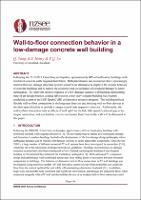| dc.contributor.author | Yang, Qun | |
| dc.contributor.author | Henry, Rick | |
| dc.contributor.author | Lu, Yiqiu | |
| dc.date.accessioned | 2021-06-22T04:02:02Z | |
| dc.date.available | 2021-06-22T04:02:02Z | |
| dc.date.issued | 2021-04-14 | |
| dc.identifier.uri | https://repo.nzsee.org.nz/xmlui/handle/nzsee/2406 | |
| dc.description.abstract | Following the 2010/2011 Canterbury earthquakes, approximately 60% of multi-story buildings with reinforced concrete walls required demolition. Both practitioners and researchers have increasingly realized that low-damage structural systems could be an alternative to improve the seismic behavior of concrete buildings and to reduce the economic and social impact of structural damage in future earthquakes. To verify the seismic response of a low-damage concrete wall building representing state-of-art design practice, a shake table test on a two-story concrete building was recently conducted as part of an ILEE-QuakeCoRE collaborative research program. The building utilized flexible wall-to-floor connections in the long span direction and isolating wall-to-floor devices in the short span direction to provide a comparison of their respective behavior. Additionally, the wall-to-floor interaction such as effects of wall uplift on the link slab, quantification of gap in the tongue connection, and acceleration transfer mechanism from floor to the wall will be discussed in this paper. | |
| dc.language.iso | en | |
| dc.publisher | New Zealand Society for Earthquake Engineering | |
| dc.relation.ispartofseries | 2021;0094 | |
| dc.subject | Improving understanding of seismic hazard and risk | |
| dc.subject | Innovative approaches in seismic design and assessment | |
| dc.title | Wall-to-floor connection behavior in a low-damage concrete wall building | |
| dc.type | Article | |

